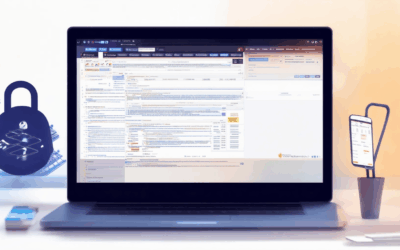In today’s interconnected world, the importance of internet security measures has never been more evident. As we increasingly rely on digital platforms for personal and professional activities, safeguarding our data and digital assets has become paramount. Whether it’s protecting sensitive information, securing financial transactions, or ensuring business continuity, the need for robust security measures is paramount. From network security to website safety, internet security measures form the backbone of modern cybersecurity practices. In this comprehensive guide, we’ll explore the essential steps, strategies, and tools needed to fortify your digital defenses, helping you navigate the complexities of internet security with confidence and clarity. By understanding the key measures and adopting best practices, you can protect your personal and professional information from evolving threats, ensuring a secure online environment for years to come.
Key Takeaways
– Strong Passwords: Use complex, unique passwords for every account to enhance security.
– Multi-Factor Authentication (MFA): Enable MFA to add an extra layer of protection beyond traditional passwords.
– Regular Software Updates: Keep all systems and software current to patch vulnerabilities and defend against threats.
– Encryption: Secure data at rest and in transit using advanced encryption methods like AES and SSL/TLS.
– Data Backup: Regularly back up critical data to prevent loss from ransomware or hardware failures.
– Network Segmentation: Isolate your network into separate segments to limit breach impact.
– Firewalls and Antivirus: Implement these tools to block malicious traffic and protect against malware.
– Role-Based Access Control (RBAC): Limit system access to authorized personnel to reduce insider threats.
– Intrusion Detection and Prevention Systems (IDPS): Deploy these to monitor and block unauthorized access in real time.
– VPN Usage: Secure remote access with VPNs to encrypt data during transmission.
– Patch Management: Regularly update and replace outdated software components to eliminate vulnerabilities.
– Employee Education: Train staff to recognize threats like phishing and adopt safe practices to mitigate human errors.
– Incident Response Plan: Prepare a swift response strategy to contain and address security breaches effectively.
– Security Policies: Develop and enforce strict guidelines to govern data handling and access.
– Penetration Testing: Regularly test systems to uncover and fix security gaps before attackers exploit them.
– Phishing Simulation: Use realistic exercises to train employees on identifying and avoiding phishing attempts.
– Public Awareness Campaigns: Educate users on online safety to reduce vulnerability to cyber threats.
– BlindBrowser.com: Explore tools and resources to enhance your cybersecurity measures comprehensively.

What are the three basic network security measures?
Here are the three fundamental network security measures:
- Encryption : Protecting data through encoding to ensure only authorized parties can access it. This is crucial for safeguarding sensitive information like passwords and financial details.
Learn more about encryption on BlindBrowser . - Strong Passwords : Using complex combinations of letters, numbers, and symbols to create unique and hard-to-guess passwords. This prevents unauthorized access to your accounts.
Explore password management tips on BlindBrowser . - Regular Software Updates : Keeping your software applications and systems up-to-date ensures that security vulnerabilities are patched, reducing the risk of attacks.
Stay informed with the latest network security news .
Internet Safety Measures
Ensuring internet safety is crucial in today’s digital age. Here are key steps to protect yourself online:
1. Use Strong Passwords
Create complex passwords with a mix of letters, numbers, and symbols. Consider using a password manager to store and organize your credentials securely.
2. Enable Two-Factor Authentication
Protect your accounts with two-step verification. This adds an extra layer of security beyond just your password, often requiring a code sent to your phone or through an authenticator app.
3. Regularly Update Software
Keep your operating systems, browsers, and apps updated to patch vulnerabilities that hackers could exploit. Many updates include security fixes that prevent cyberattacks.
4. Encrypt Your Devices
Use encryption for sensitive data stored on your devices. Enable BitLocker on Windows, use FileVault on macOS, and ensure your mobile devices have encryption enabled.
5. Be Cautious with Public Wi-Fi
When connecting to public networks, use a VPN for added privacy. Avoid sharing personal information or conducting financial transactions on untrusted networks.
6. Monitor Network Traffic
Use tools like network monitoring software to inspect and block unauthorized access to your network.
7. Backup Your Data
Regularly back up important files to an external drive or cloud storage. This ensures you can recover lost data in case of ransomware attacks or hardware failures.
8. Educate Yourself
Stay informed about the latest cybersecurity threats and scams. Follow reputable sources like FTC for updates on common fraud schemes.
9. Use a VPN
Virtual Private Networks (VPNs) hide your IP address and encrypt your internet connection, offering enhanced privacy and security, especially when browsing from public locations.
10. Report Suspicious Activity
If you notice unusual activity on your accounts, report it immediately to your provider. Early detection can prevent significant harm and help improve overall security measures.
By following these steps, you can significantly reduce your risk of falling victim to cyber threats and enjoy a safer online experience.

5 Ways to Protect Your Online Security
- Use Strong Passwords: Create complex passwords with a mix of letters, numbers, and symbols. Avoid reusing passwords across multiple accounts.
- Enable Two-Factor Authentication: Add an extra layer of security by using codes sent to your phone or through an authenticator app.
- Regularly Update Software: Keep your operating systems, browsers, and apps updated to patch vulnerabilities.
- Install Antivirus Software: Use reputable antivirus programs to detect and block malicious threats.
- Be Cautious with Links: Hover over links to see the full URL before clicking, and avoid clicking on suspicious or unknown links.

What are security measures in cybersecurity?
Security measures in cybersecurity are essential to protect systems, networks, and data from unauthorized access, breaches, and threats. Here are some key security practices that form the foundation of robust cybersecurity:
Fundamental Security Practices
- Strong Passwords : Use complex passwords with a mix of letters, numbers, and symbols. Avoid reusing passwords across multiple accounts.
- Multi-Factor Authentication (MFA) : Enable MFA to add an extra layer of security beyond a password, often through SMS codes, authenticator apps, or biometric verification.
- Regular Software Updates : Keep all software, applications, and operating systems updated to patch vulnerabilities and exploit fixes.
- Encryption : Encrypt sensitive data, whether it’s stored on devices, transmitted over networks, or stored in the cloud.
- Data Backup : Regularly backup important data to prevent loss in case of ransomware attacks or hardware failures.
- Network Segmentation : Divide your network into segments to limit the spread of potential breaches.
- Firewalls and Antivirus Software : Use firewalls and antivirus solutions to monitor and block malicious traffic and malware.
- Access Control : Limit access to sensitive systems and data to only authorized personnel, using role-based access control (RBAC).
Technical Defenses
- Intrusion Detection and Prevention Systems (IDPS) : Implement systems to detect and block unauthorized access attempts in real-time.
- VPN Usage : Secure remote access to internal networks using Virtual Private Networks (VPNs) to encrypt data in transit.
- DMZ (Demilitarized Zone) : Create a DMZ to isolate servers and services from the internal network, reducing attack surfaces.
- Patch Management : Regularly update and replace outdated software components to eliminate known vulnerabilities.
- Honeypots : Deploy decoy systems to attract and track potential attackers, helping to understand and mitigate threats.
Policies and Procedures
- Security Policies : Develop and enforce strict security policies across your organization, including acceptable use, incident response, and data handling procedures.
- Penetration Testing : Conduct regular penetration testing to identify and fix security gaps before attackers can exploit them.
- Security Training : Train employees to recognize phishing attempts, social engineering tactics, and other common security threats.
- Incident Response Plan : Have a well-defined plan in place to respond to and contain security incidents quickly.
Education and Awareness
- Public Awareness Campaigns : Educate users about the importance of security measures and how to protect themselves online.
- Social Media Security : Monitor and manage social media accounts to prevent data leaks or misuse of personal information.
- Phishing Simulation : Use simulated phishing exercises to train employees to recognize and avoid phishing attacks.
By implementing these security measures, organizations can significantly reduce their risk of cyberattacks and safeguard sensitive data. Remember, cybersecurity is a continuous process that requires ongoing vigilance and adaptation to evolving threats.
What Are the 5 Best Methods Used for Cyber Security?
- Encryption : Securely encrypt sensitive data such as passwords, credit card numbers, and communications to prevent unauthorized access. Use protocols like SSL/TLS for data in transit and AES for data at rest.
- Multi-Factor Authentication (MFA) : Implement MFA to require users to provide two or more forms of verification before accessing accounts. This significantly reduces the risk of unauthorized access compared to single-factor authentication.
- Regular Software Updates : Keep all software applications, operating systems, and hardware devices updated to the latest versions to patch vulnerabilities and protect against known threats.
- Network Segmentation : Divide your network into separate segments to limit the spread of potential breaches. This ensures that an attack on one segment does not compromise the entire network.
- Employee Education and Awareness : Train employees to recognize phishing attempts, understand best practices, and stay informed about emerging threats. Human error is often a leading cause of security breaches, so continuous education is crucial.
For more resources and tools to enhance your cybersecurity measures, visit BlindBrowser.com . Our platform offers comprehensive guides, tools, and insights to help you safeguard your digital presence effectively.

What are the three security measures?
BlindBrowser.com emphasizes the importance of implementing robust security measures to safeguard sensitive information and ensure digital privacy. Below are the three primary security measures that every organization should prioritize:
1. Physical Security
Physical security involves protecting your assets from unauthorized access or theft. Here are the key components:
- Access Control: Restrict entry to authorized personnel and secure areas.
- Encryption: Secure data storage devices using strong encryption methods.
- Surveillance Systems: Install cameras and alarms to monitor premises and detect intrusions.
2. Technical Security
Technical security focuses on safeguarding systems, networks, and data from cyber threats. Key aspects include:
- Firewalls: Implement network firewalls to block unauthorized access.
- Multi-Factor Authentication (MFA): Require users to provide two or more forms of verification before accessing systems.
- Regular Software Updates: Keep all software applications and systems up-to-date to patch vulnerabilities.
3. Administrative Security
Administrative security ensures that policies and procedures are in place to minimize risks. Essential steps include:
- Policies and Procedures: Develop and enforce strict security policies, including data handling and access protocols.
- Security Training: Regularly train employees on cybersecurity best practices to reduce human error risks.
- Incident Response Plan: Have a plan in place to respond to and mitigate security breaches effectively.
By combining these three security measures, organizations can significantly reduce their risk of exposure to threats and ensure the protection of their valuable assets. Remember to always stay updated on the latest security trends and implement safeguards to maintain compliance with regulations like GDPR or CCPA.




